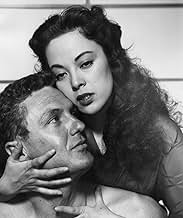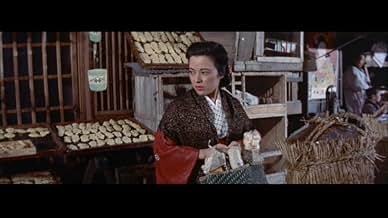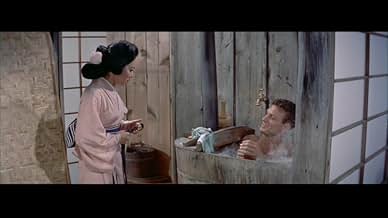NOTE IMDb
6,8/10
4,4 k
MA NOTE
Infiltré dans un syndicat du crime à Tokyo, un enquêteur de l'armée américaine tente d'éclaircir en parallèle la mort d'un collègue de l'armée.Infiltré dans un syndicat du crime à Tokyo, un enquêteur de l'armée américaine tente d'éclaircir en parallèle la mort d'un collègue de l'armée.Infiltré dans un syndicat du crime à Tokyo, un enquêteur de l'armée américaine tente d'éclaircir en parallèle la mort d'un collègue de l'armée.
- Réalisation
- Scénario
- Casting principal
Clifford Arashiro
- Policeman
- (non crédité)
Sandy Azeka
- Charlie's Girl at Party
- (non crédité)
Harry Carey Jr.
- John
- (non crédité)
Barry Coe
- Captain Hanson's Aide
- (non crédité)
John Doucette
- Skipper
- (non crédité)
Fuji
- Pachinko Manager
- (non crédité)
Samuel Fuller
- Japanese policeman
- (non crédité)
Peter Gray
- Willy
- (non crédité)
Avis à la une
I had fun through most of House of Bamboo, Samuel Fuller's second widescreen, first filmed out-of-the-US picture, even as I knew at the end it wasn't too special. It's got some memorable scenes with the two male leads, the kind of seemingly hard-boiled actors that probably wouldn't shake much if you hit them with some punches. And the whole plot line of the American crime ring in Tokyo in 1955 gives enough room for Fuller to realize some of the acting, camera and editing possibilities at his big-studio disposal. Robert Stack is in one of his best early parts as a would-be big crook undercover for the US army who infiltrates Robert Ryan's 'organization', where its tightly run to the point where Ryan's ready and willing to kill his own if wounded in the moment of crime. On top of this, Stack falls for a 'kimono' who was married to a late-member of the crime team. But will the deceiving remain?
The majority of the film works under the crime parts of the story, where in some scenes (maybe or maybe not in the new cinema-scope style) Fuller just keeps the camera on the scene without cutting. This room and space and time does create the right tension- and occasional humor- in the right spots. And Ryan is also up to task as the cold antagonist. Yet if there are parts of the film that are lesser than the bulk of it I'd say it would be with the 'Kimono' Mauriko, played by Shirley Yamaguchi. Her part in the story is mandatory to be sure, but it is just so-so in the writing and delivery, as far as such a formula would allow. And it is probably more of the writer's fault and even on Yamaguchi's end, arguably, than Fuller's. There are also some typical, dated bits of 'lost in translation' moments that may be part of the deal in making the very first Hollywood movie filmed entirely in Tokyo- they're 50/50 of doing the job for the entertaining parts of the picture.
Nonetheless, House of Bamboo is a more than decent example of what can be done with other material from one setting into another (both from a 40's noir, Street with No Name, and from US to Japan). There is also a sweet, if not greatly paced, climax in a wheel machine on a roof. It's gritty machismo with fun, with enough pure Fuller to suffice the studio standards.
The majority of the film works under the crime parts of the story, where in some scenes (maybe or maybe not in the new cinema-scope style) Fuller just keeps the camera on the scene without cutting. This room and space and time does create the right tension- and occasional humor- in the right spots. And Ryan is also up to task as the cold antagonist. Yet if there are parts of the film that are lesser than the bulk of it I'd say it would be with the 'Kimono' Mauriko, played by Shirley Yamaguchi. Her part in the story is mandatory to be sure, but it is just so-so in the writing and delivery, as far as such a formula would allow. And it is probably more of the writer's fault and even on Yamaguchi's end, arguably, than Fuller's. There are also some typical, dated bits of 'lost in translation' moments that may be part of the deal in making the very first Hollywood movie filmed entirely in Tokyo- they're 50/50 of doing the job for the entertaining parts of the picture.
Nonetheless, House of Bamboo is a more than decent example of what can be done with other material from one setting into another (both from a 40's noir, Street with No Name, and from US to Japan). There is also a sweet, if not greatly paced, climax in a wheel machine on a roof. It's gritty machismo with fun, with enough pure Fuller to suffice the studio standards.
This movie has similarities to THE THIRD MAN in that both involve someone (an American) living comfortably in an alien culture as a parasitic gangster in a war ravaged country just after WW2 with a good guy (another American) in pursuit. In narrow cinematic terms, in terms of the story as other reviewers point out, its not a great movie. There is though very much more of interest to it than that.
In historical terms we see Tokyo as it then was in 1954. We see the Japanese as officials, as policemen, as gangsters, the good, the bad, in their natural habitat rather than simply as massed cruel soldiery or suicidal pilots. It has elements of a travelogue with a fascinating glimpse behind the rice paper screen. The movie, which has really handsome colour photography, starts with the curious beauty of a snow covered landscape with Mount Fuji in the background and a murderous attack on a military supply train in the foreground. The ending too shares the same deliberate disjunction - dark violent justice dealt out in a sunny family setting - Top of the World, Ma?
Robert Stack here very much pre-figures his role as Eliot Ness in THE UNTOUCHABLES - dogged and brave in the fight against organised crime. Robert Ryan, tall impeccably elegant and seemingly entirely at ease as a violent mobster in a very foreign land.
Much criticism seems carping and misses the point. As was said of the dog that could walk upright - the question was not so much that he couldn't do it perfectly but that he could do it at all. This was a unique bold movie embedded in post WW2 underworld Japan really striving for authenticity. Not the customary montage of tourist sites and hotel interiors with a cast looking as if they'd gone no further than that themselves.
Were there American gangsters in this way in post war Japan? Presumably so if CATCH 22 is any guide. In this movie however the morality is old-fashioned, certain and unambiguous. By 1970 CATCH 22 served up satire and moral ambiguity to the Hippy generation.
A fascinating little bit of history as well as being a very watchable movie
In historical terms we see Tokyo as it then was in 1954. We see the Japanese as officials, as policemen, as gangsters, the good, the bad, in their natural habitat rather than simply as massed cruel soldiery or suicidal pilots. It has elements of a travelogue with a fascinating glimpse behind the rice paper screen. The movie, which has really handsome colour photography, starts with the curious beauty of a snow covered landscape with Mount Fuji in the background and a murderous attack on a military supply train in the foreground. The ending too shares the same deliberate disjunction - dark violent justice dealt out in a sunny family setting - Top of the World, Ma?
Robert Stack here very much pre-figures his role as Eliot Ness in THE UNTOUCHABLES - dogged and brave in the fight against organised crime. Robert Ryan, tall impeccably elegant and seemingly entirely at ease as a violent mobster in a very foreign land.
Much criticism seems carping and misses the point. As was said of the dog that could walk upright - the question was not so much that he couldn't do it perfectly but that he could do it at all. This was a unique bold movie embedded in post WW2 underworld Japan really striving for authenticity. Not the customary montage of tourist sites and hotel interiors with a cast looking as if they'd gone no further than that themselves.
Were there American gangsters in this way in post war Japan? Presumably so if CATCH 22 is any guide. In this movie however the morality is old-fashioned, certain and unambiguous. By 1970 CATCH 22 served up satire and moral ambiguity to the Hippy generation.
A fascinating little bit of history as well as being a very watchable movie
No need to recap the plot. The movie's one-third caper film, one-third romance, and one- third travelogue. Cult filmmaker Fuller tries to bring them together, but only partially succeeds, despite that colorful climax with the revolving globe and the rooftop view of Tokyo. Two of Fuller's usual concerns prevail here as elsewhere—culture clash and military organization.
Mariko and Eddie must work through their cultural differences before establishing a real relationship. Screenwriter Fuller spends a lot of time with this, maybe too much since it drags out the pacing. However, I suspect he was revealing a timely cultural glimpse to American audiences—remember this was less than a decade after the war and, generally, Americans knew very little about their new Cold War partners or traditional Japanese society.
Surprisingly, the robbery capers are dealt with only briefly and without the expected rising tension. In fact, Fuller seems more interested in the para- military discipline that defines the gang than in the robberies themselves, an aspect that produces more talk than action. Getting the great Robert Ryan (Sandy) as the gang's "5-star general" was the real casting coup since it's his fierceness that delivers the film's main impact. (In passing—Griff's {Mitchell} attachment to Sandy appears ambiguous enough to be interesting for the time.)
Frankly, I liked the travelogue parts best. Fuller does a good job working these into the story, while the scenes themselves of Japanese landmarks and street crowds are colorful as heck. Anyway, the movie's too uneven and diffuse to have real impact. Still, it does remain a visual treat despite the passing decades.
Mariko and Eddie must work through their cultural differences before establishing a real relationship. Screenwriter Fuller spends a lot of time with this, maybe too much since it drags out the pacing. However, I suspect he was revealing a timely cultural glimpse to American audiences—remember this was less than a decade after the war and, generally, Americans knew very little about their new Cold War partners or traditional Japanese society.
Surprisingly, the robbery capers are dealt with only briefly and without the expected rising tension. In fact, Fuller seems more interested in the para- military discipline that defines the gang than in the robberies themselves, an aspect that produces more talk than action. Getting the great Robert Ryan (Sandy) as the gang's "5-star general" was the real casting coup since it's his fierceness that delivers the film's main impact. (In passing—Griff's {Mitchell} attachment to Sandy appears ambiguous enough to be interesting for the time.)
Frankly, I liked the travelogue parts best. Fuller does a good job working these into the story, while the scenes themselves of Japanese landmarks and street crowds are colorful as heck. Anyway, the movie's too uneven and diffuse to have real impact. Still, it does remain a visual treat despite the passing decades.
At the end of the movie Robert Ryan doesn't fire more shots than he has ammunition. Look closely at the start of the pearl robbery, when the armourer is handing out weapons. Before he hands Ryan the P38 he gives him at least four spare magazines which Ryan clips to his belt.
House Of Bamboo came out in 1955 three years after the Japanese Peace Treaty effectively ended the occupation of Japan that began post World War II. Americans must have been familiar sight on the streets of Japanese cities still in 1955, we certainly had enough military personnel there. If you don't recognize that fact than you will be puzzled as to how a gang of Americans crooks could operate the way they do in the streets of Tokyo.
For those of you who don't recognize it screenwriter Harry Kleiner took the screenplay he wrote for the Henry Hathaway classic, The Street With No Name and set in down in post occupation Japan. Robert Ryan plays the gang leader part that Richard Widmark had. He's recruited a gang of former military misfits who spent more time in the stockade than in combat and made them into an effective heist gang. Ryan's got other interests, but his main income is from some well planned robberies.
The USA military intelligence gets involved when Ryan hijacks a train with military hardware and kills a soldier. Going undercover is Robert Stack in the Mark Stevens part.
Unlike The Street With No Name, Stack's allowed a little romance here in the person of Japanese actress Shirley Yamaguchi. In The Street With No Name it was Widmark who had the girlfriends and Stevens was strictly business. Sessue Hayakawa is also in the cast as the Japanese police inspector.
There's a gay subtext in the film with the relationship of Ryan with his number two, Cameron Mitchell. When Stack starts to take his place in the gang hierarchy, Mitchell reactions are of pure jealousy. In fact Mitchell's reactions are what sets in motion the climax of the film.
Which you know if you've seen The Street With No Name. House Of Bamboo boasts some mighty nice location shots of postwar Tokyo which looking at it you would hardly believe what a difference a decade might make. The title House Of Bamboo is the place that Ryan lives in and it's a pre-war structure typical of the Tokyo before General Doolittle inaugurated US bombing raids. Those wooden houses went up like tinder boxes. Note the more modern look Tokyo has in 1955.
The color might disqualify House Of Bamboo from the genre, but the film as the look and feel of a good noir film. Which is as good a recommendation as I can give it.
For those of you who don't recognize it screenwriter Harry Kleiner took the screenplay he wrote for the Henry Hathaway classic, The Street With No Name and set in down in post occupation Japan. Robert Ryan plays the gang leader part that Richard Widmark had. He's recruited a gang of former military misfits who spent more time in the stockade than in combat and made them into an effective heist gang. Ryan's got other interests, but his main income is from some well planned robberies.
The USA military intelligence gets involved when Ryan hijacks a train with military hardware and kills a soldier. Going undercover is Robert Stack in the Mark Stevens part.
Unlike The Street With No Name, Stack's allowed a little romance here in the person of Japanese actress Shirley Yamaguchi. In The Street With No Name it was Widmark who had the girlfriends and Stevens was strictly business. Sessue Hayakawa is also in the cast as the Japanese police inspector.
There's a gay subtext in the film with the relationship of Ryan with his number two, Cameron Mitchell. When Stack starts to take his place in the gang hierarchy, Mitchell reactions are of pure jealousy. In fact Mitchell's reactions are what sets in motion the climax of the film.
Which you know if you've seen The Street With No Name. House Of Bamboo boasts some mighty nice location shots of postwar Tokyo which looking at it you would hardly believe what a difference a decade might make. The title House Of Bamboo is the place that Ryan lives in and it's a pre-war structure typical of the Tokyo before General Doolittle inaugurated US bombing raids. Those wooden houses went up like tinder boxes. Note the more modern look Tokyo has in 1955.
The color might disqualify House Of Bamboo from the genre, but the film as the look and feel of a good noir film. Which is as good a recommendation as I can give it.
Le saviez-vous
- AnecdotesAccording to Robert Stack, Samuel Fuller told an actor to go down really low when he passed a 50-gallon drum. Without informing the actor, the director had a sharpshooter on a parallel who shot over the man's head and into the drum. After it blew up, the actor said, "Jesus Christ! Those were real bullets!" Fuller laconically replied, "Don't worry. He knew what he was doing."
- GaffesSandy fires an awful lot of shots from his pistol (which is a revolver) without ever appearing to reload it.
- Citations
Sandy Dawson: Who are you working for?
Eddie Kenner: [posing as Eddie Spanier] Spanier.
Sandy Dawson: Who's Spanier?
Eddie Kenner: Me.
Sandy Dawson: Who else you working for?
Eddie Kenner: Eddie.
- ConnexionsEdited into Shock Corridor (1963)
Meilleurs choix
Connectez-vous pour évaluer et suivre la liste de favoris afin de recevoir des recommandations personnalisées
- How long is House of Bamboo?Alimenté par Alexa
Détails
- Date de sortie
- Pays d’origine
- Langues
- Aussi connu sous le nom de
- Maison de bambou
- Lieux de tournage
- Tokyo, Japon(rooftop playground of the Matsuma department store)
- Société de production
- Voir plus de crédits d'entreprise sur IMDbPro
Box-office
- Budget
- 1 380 000 $US (estimé)
- Durée
- 1h 42min(102 min)
- Rapport de forme
- 2.55 : 1
Contribuer à cette page
Suggérer une modification ou ajouter du contenu manquant























